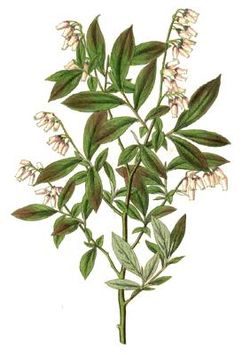Vaccinium virgatum
| Habit | shrub
| |
|---|---|---|
| Height: | ⇕ | 3 ft"ft" can not be assigned to a declared number type with value 3. to 15 ft"ft" can not be assigned to a declared number type with value 15. |
| Width: | ⇔ | 7 ft"ft" can not be assigned to a declared number type with value 7. |
| Lifespan: | ⌛ | perennial |
| Exposure: | ☼ | part-sun |
|---|---|---|
| Water: | ◍ | moist |
| Features: | ✓ | deciduous, edible, fruit |
| USDA Zones: | 8 to 10.5 |
|
virgatum > |
Rabbiteye Blueberry (Vaccinium virgatum, also known as V. ashei) is a species of blueberry native to the southeastern United States, from North Carolina south to Florida and west to Texas. Other common names include Southern Highbush Blueberry, Southern Black Blueberry, and Smallflower Blueberry.
It is a deciduous shrub growing to 4 m tall, though usually less, commonly only 1-2 m tall. The leaves are spirally arranged, oblanceolate to narrow elliptic, 3-6 cm long. The flowers are white, bell-shaped, 5 mm long. The fruit is a berry 5 mm diameter, dark blue to black, bloomed pale blue-gray by a thin wax coating. It grows best on acid soil and is subject to few pests and diseases.
Rabbiteye blueberries are self infertile and must have two or more varieties to pollenize each other. Honeybees are inefficient pollinators, and carpenter bees frequently cut the corollas to rob nectar without pollinating the flowers. Rabbiteyes do best when pollinated by buzz pollination by bees, such as the native southeastern blueberry bee, Habropoda laboriosa.
The species is cultivated for its edible berries, which are similar to other blueberries. It is also grown as an ornamental plant for its fall colors, typically bright orange or red.
Read about Vaccinium virgatum in the Standard Cyclopedia of Horticulture
|
|---|
|
Vaccinium virgatum, Ait. A shrub 2-12 ft. high, with slender green branchlets, the young twigs puberulent: lvs. ovate-oblong to cuneate-lanceolate, 3/4 - 2 in. long, thinnish, acute, often mucronate, entire or minutely serrulate, green and glabrous above, pale or glaucous beneath; veins pubescent: fls. in short racemes, on naked twigs, appearing before the lvs.; corolla long and nearly cylindrical, 1/4 – 3/8 in. long, white or pink: bracts small, deciduous: terry black, almost or quite destitute of bloom. Swamps, S. Va. to Fla. and La.).—The distinction between this species and V. corymbosum is very slight. It is probable that, possibly excepting var. tenellum, this is only a southern form of V. corymbosum and should be reduced to varietal rank. Var. tenellum, Gray (V. tenellum, Ait.). A low form, mostly less than 2 ft. high, with smaller lvs. and nearly white fls. in short close clusters. S. Va. to Ark., Fla., and Ala.
|
- More information about this species can be found on the genus page.
Cultivation
- Do you have cultivation info on this plant? Edit this section!
Propagation
- Do you have propagation info on this plant? Edit this section!
Pests and diseases
- Do you have pest and disease info on this plant? Edit this section!
Cultivars
- Var. tenellum. A low form, mostly less than 2 ft. high, with smaller lvs. and nearly white fls. in short close clusters. S. Va. to Ark., Fla., and Ala.
Gallery
If you have a photo of this plant, please upload it! Plus, there may be other photos available for you to add.
References
External links
- w:Vaccinium virgatum. Some of the material on this page may be from Wikipedia, under the Creative Commons license.
- Vaccinium virgatum QR Code (Size 50, 100, 200, 500)

